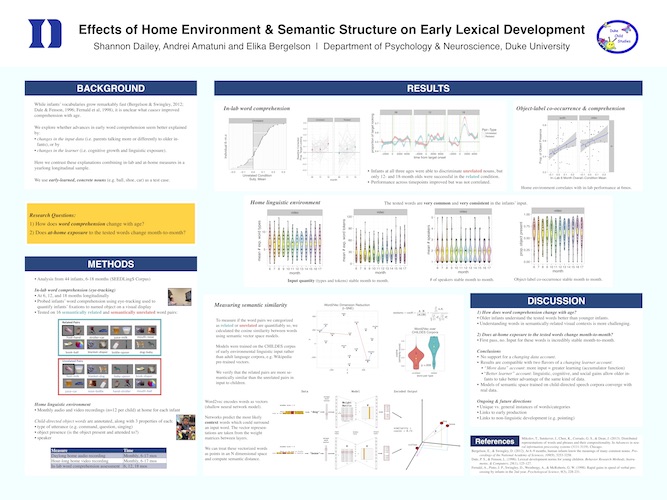Effects of Home Environment & Semantic Structure on
Early Lexical Development
Dailey, Amatuni & Bergelson (2016)
Presented at NIH High Risk, High-Reward Research Symposium 2016, Bethesda, MD
Abstract
While infants’ vocabularies grow remarkably fast (Bergelson & Swingley, 2012; Dale & Fenson, 1996; Fernald et al, 1998), it is unclear what causes improved comprehension with age. We explore whether advances in early word comprehension seem better explained by changing input data, i.e. parents talking more or differently to older infants, or by changes in the learner, i.e. cognitive growth and linguistic exposure. These possibilities have different implications for how to best support early language-learning for at-risk children. Here we contrast these explanations using early-learned nouns as a test-case, combining in-lab and at-home measures in a yearlong longitudinal sample (n=44).
We probed infants’ word comprehension across two contexts (semantically-related and semantically-distinct word-pairs) at 3 time-points (6, 12, and 18 months) using eye-tracking to quantify infants’ fixations to named object on a visual display. We further analyzed the input statistics of the tested words in a corpus of monthly daylong audio-recordings and hour-long video-recordings of these same children at home. We asked whether 1) in-lab comprehension is modulated by age and semantic context and 2) home exposure to the tested words changes month-to-month. No extant datasets combine such environmental and behavioral data within the same infants.
Mixed-effects models and non-parametric tests indicated that 12- and 18-month-olds exhibited above-chance performance across semantic contexts, but 6-m.o.s only did so in the semanticallydistinct condition. 78% of infants attained positive means (M= .064, p=.00043 by Binomial Test). These results suggest that even infants’ earliest words are part of interconnected lexical networks; relations between words affect comprehension for infants, as for adults. Corpus analyses revealed high and consistent rates of exposure to the tested words: on an average recording infants heard 50-100% of our tested words, with multiple instances of each. Tested words were heard from ~2 speakers, and the words’ referents were available and attended to ~60% of the time infants heard them said aloud. There was no evidence for changing exposure over time, ruling out a ‘changing data’ account. Indeed, infants’ word exposure was incredibly stable over time.
Infants’ improvement from 6-18 months does not seem to reflect relatively more word-instances over time, more talker-variability, or different exposure conditions. Rather, improvement seems to stem from an accrual of similar learning instances, and growing differentiation of related concepts. This in turn is compatible with several accounts. On a “more data” account, data accrual increases learning. On a “better learner” account, linguistic, cognitive, and social gains let older infants take better advantage of the same kind of data. We explore how to adjudicate between these accounts, and to unpack what the variability in home and lab measures can tell us about early language development.
